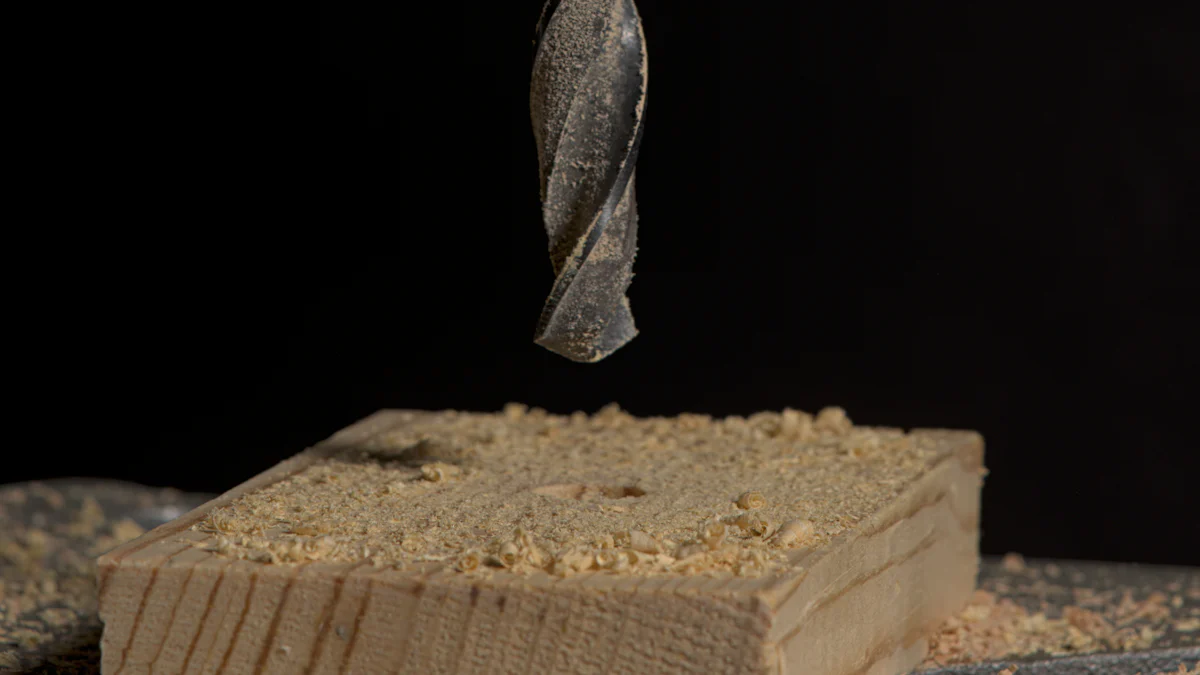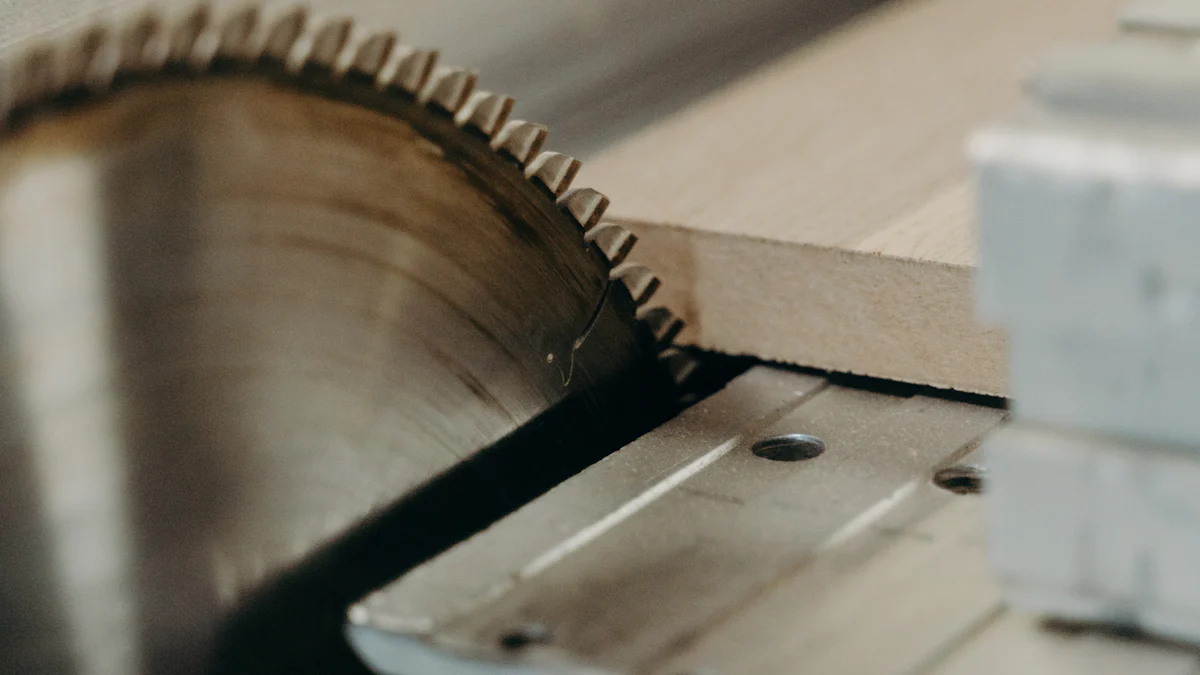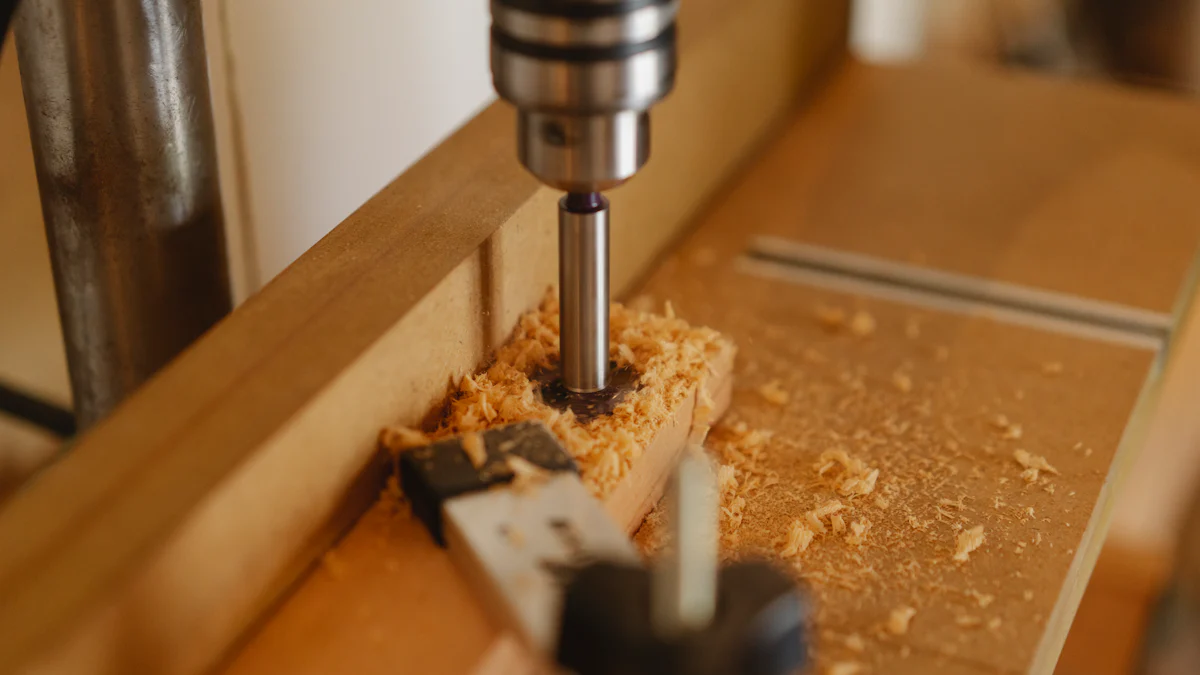
Hole cutting plays a crucial role in woodworking. Woodworkers rely on precise and clean holes for various applications, from joinery to hardware installation. A wide range of hole cutting tools exists, each designed for specific tasks and materials. This blog aims to provide a comprehensive review of the top 5 hole cutting tools, helping woodworkers make informed decisions.
Factors to Consider When Choosing Hole Cutting Tools

Material Compatibility
Wood Types
Different wood types require specific hole cutting tools. Hardwoods like oak and maple need robust tools with sharp edges. Softwoods such as pine and cedar allow for more flexibility in tool choice. Plywood and MDF present unique challenges due to their layered structure. Selecting the appropriate tool for each wood type ensures clean cuts and prolongs tool life.
Tool Material
The material of the hole cutter impacts performance and durability. High-speed steel (HSS) offers good performance for general woodworking. Carbide-tipped tools provide superior durability and cutting efficiency, especially for hardwoods. Bi-metal hole saws combine flexibility and strength, making them suitable for various wood types. Understanding tool material helps in choosing a cutter that matches the project’s demands.
Precision and Accuracy
Measurement Tools
Accurate measurements ensure precise hole placement. Calipers and rulers provide essential measurement accuracy. Marking gauges help in transferring measurements onto the wood surface. Laser guides offer advanced precision for critical projects. Using the right measurement tools enhances the overall quality of the woodworking project.
Cutting Techniques
Proper cutting techniques contribute to precision and accuracy. Drilling pilot holes prevents the drill bit from wandering. Using clamps secures the workpiece, reducing movement during cutting. Employing a steady hand and consistent pressure ensures smooth and accurate cuts. Mastering these techniques improves the final outcome of the woodworking project.
Ease of Use
Ergonomics
Ergonomically designed tools reduce user fatigue and increase efficiency. Comfortable grips and well-balanced designs allow for extended use without discomfort. Lightweight tools minimize strain on the hands and wrists. Prioritizing ergonomics enhances the overall user experience and productivity.
User Experience
User-friendly features simplify the woodworking process. Quick-change mechanisms enable fast bit swaps, saving time. Clear depth markings assist in achieving consistent hole depths. Dust extraction ports keep the workspace clean and improve visibility. Focusing on user experience leads to more enjoyable and efficient woodworking sessions.
Durability and Maintenance
Tool Longevity
Selecting high-quality materials for hole cutting tools ensures extended tool life. High-speed steel (HSS) tools offer good durability for general woodworking tasks. Carbide-tipped tools provide exceptional longevity, especially when working with hardwoods. Bi-metal hole saws combine flexibility and strength, making them suitable for various wood types. Regular inspection of tools for wear and tear helps in maintaining their performance. Investing in durable tools reduces the frequency of replacements and enhances project outcomes.
Maintenance Tips
Proper maintenance practices extend the lifespan of hole cutting tools. Cleaning tools after each use prevents the buildup of wood debris and resin. Using a brush or compressed air effectively removes particles from cutting edges. Sharpening tools periodically maintains their cutting efficiency. Applying a light coat of oil to metal parts prevents rust and corrosion. Storing tools in a dry, organized environment protects them from damage. Following these maintenance tips ensures that hole cutting tools remain in optimal condition for future projects.
Top 5 Hole Cutting Tools

Tool 1: Hole Saw
Features
A hole saw consists of a cylindrical saw blade attached to a drill. The teeth on the blade cut through wood, creating large holes. Hole saws come in various sizes, allowing for versatility in woodworking projects. Many models include a pilot bit to guide the saw and prevent wandering.
Pros and Cons
Hole saws offer the ability to cut large diameter holes efficiently. The design allows for quick and clean cuts. However, removing the cut material from the saw can be challenging. Some models may struggle with thicker wood, requiring more power.
Best Uses
Hole saws excel in creating holes for door hardware, plumbing installations, and electrical work. Woodworkers often use them for making large openings in cabinetry and furniture. The tool’s versatility makes it a staple in many woodworking shops.
Tool 2: Forstner Bit
Features
Forstner bits feature a flat cutting edge with a central point. The design allows for precise and clean holes with flat bottoms. These bits can cut overlapping holes and work well at angles. Available in various sizes, Forstner bits provide flexibility in woodworking tasks.
Pros and Cons
Forstner bits deliver high precision and clean cuts. The flat bottom hole is ideal for doweling and other joinery tasks. However, these bits require more power and can generate significant heat. Frequent sharpening may be necessary to maintain performance.
Best Uses
Forstner bits are perfect for creating flat-bottomed holes in woodworking projects. These bits are ideal for dowel joints, hinge installation, and decorative inlays. The precision and versatility make them a favorite among woodworkers.
Tool 3: Spade Bit
Features
Spade bits have a flat, paddle-shaped design with a sharp point. The edges of the paddle cut through wood, creating holes quickly. These bits come in various sizes and are easy to use with standard drills.
Pros and Cons
Spade bits offer fast and efficient hole cutting. The simple design makes them affordable and easy to use. However, the holes can be rougher compared to other bits. Spade bits may also cause splintering, especially in softer woods.
Best Uses
Spade bits are ideal for drilling holes for wiring and plumbing. Woodworkers use them for rough carpentry tasks where precision is less critical. The speed and simplicity make spade bits a go-to hole cutting tool for many projects.
Tool 4: Auger Bit
Features
An auger bit features a spiral design with a screw tip. The screw tip pulls the bit into the wood, reducing the need for force. The spiral flutes remove wood chips efficiently. Auger bits come in various sizes, providing versatility for different applications.
Pros and Cons
Auger bits offer efficient chip removal and deep hole drilling. The screw tip ensures easy starting and reduces wandering. However, auger bits can generate rough holes. The large size may require a powerful drill for optimal performance.
Best Uses
Auger bits excel in drilling deep holes for tasks like timber framing. Woodworkers use them for creating holes for dowels and bolts. The efficient design makes auger bits ideal for heavy-duty woodworking projects.
Tool 5: Hole Cutter
Features
A hole cutter consists of a circular blade mounted on an arbor. The blade cuts through wood to create precise holes. Many models include adjustable blades for varying hole sizes. Hole cutters often feature carbide-tipped teeth for enhanced durability.
Pros and Cons
Hole cutters provide clean and accurate cuts. The adjustable blade design offers flexibility for different hole sizes. However, hole cutters may struggle with very thick wood. Regular maintenance is necessary to keep the blades sharp.
Best Uses
Hole cutters are perfect for making precise holes for hardware installation. Woodworkers use them for tasks like installing locks and hinges. The tool’s precision makes it a valuable addition to any woodworking shop.
Importance of Choosing the Right Hole Cutting Tool
Impact on Project Quality
Finish Quality
Selecting the appropriate hole cutting tool directly influences the finish quality of woodworking projects. High-quality tools produce clean, smooth edges that enhance the overall appearance. Poorly chosen tools often result in rough, splintered holes that detract from the final product. Investing in the right tool ensures a professional finish.
Structural Integrity
The right hole cutting tool also impacts the structural integrity of woodworking projects. Precision tools create accurate holes that fit hardware and joinery components perfectly. Inaccurate holes compromise the strength and stability of the structure. Ensuring the correct tool selection maintains the project’s durability and safety.
Efficiency and Time-Saving
Speed of Work
Proper hole cutting tools significantly increase the speed of work. Efficient tools reduce the time required to complete each hole, allowing for faster project completion. Tools designed for quick bit changes and minimal setup further enhance productivity. Choosing the right tool streamlines the workflow and maximizes efficiency.
Reducing Errors
Using the correct hole cutting tool minimizes errors during the woodworking process. Accurate tools prevent misalignment and improper hole sizes, reducing the need for rework. Fewer mistakes lead to smoother project progression and better end results. The right tool choice contributes to a more error-free woodworking experience.
Cost-Effectiveness
Tool Investment
Investing in high-quality hole cutting tools proves cost-effective in the long run. Durable tools withstand frequent use and require fewer replacements. Although initial costs may be higher, the longevity and performance of quality tools justify the investment. Proper tool selection saves money over time by reducing the need for frequent purchases.
Long-Term Savings
Choosing the right hole cutting tool also leads to long-term savings in terms of project materials. Accurate and efficient tools reduce material wastage caused by errors and poor cuts. Less waste translates to lower material costs and more sustainable woodworking practices. The right tool choice supports both financial and environmental benefits.
Selecting the right hole cutting tool holds significant importance for woodworking projects. The blog reviewed the top 5 tools: Hole Saw, Forstner Bit, Spade Bit, Auger Bit, and Hole Cutter. Each tool offers unique features and benefits for various applications. Woodworkers should consider factors like material compatibility, precision, ease of use, and durability when choosing tools. The right selection enhances project quality, efficiency, and cost-effectiveness. Investing in suitable tools ensures professional results and a more enjoyable woodworking experience.
See Also
Discovering the Range of Socks for Males and Females
Top Tips for Warm Winter with Soft Cozy Socks
